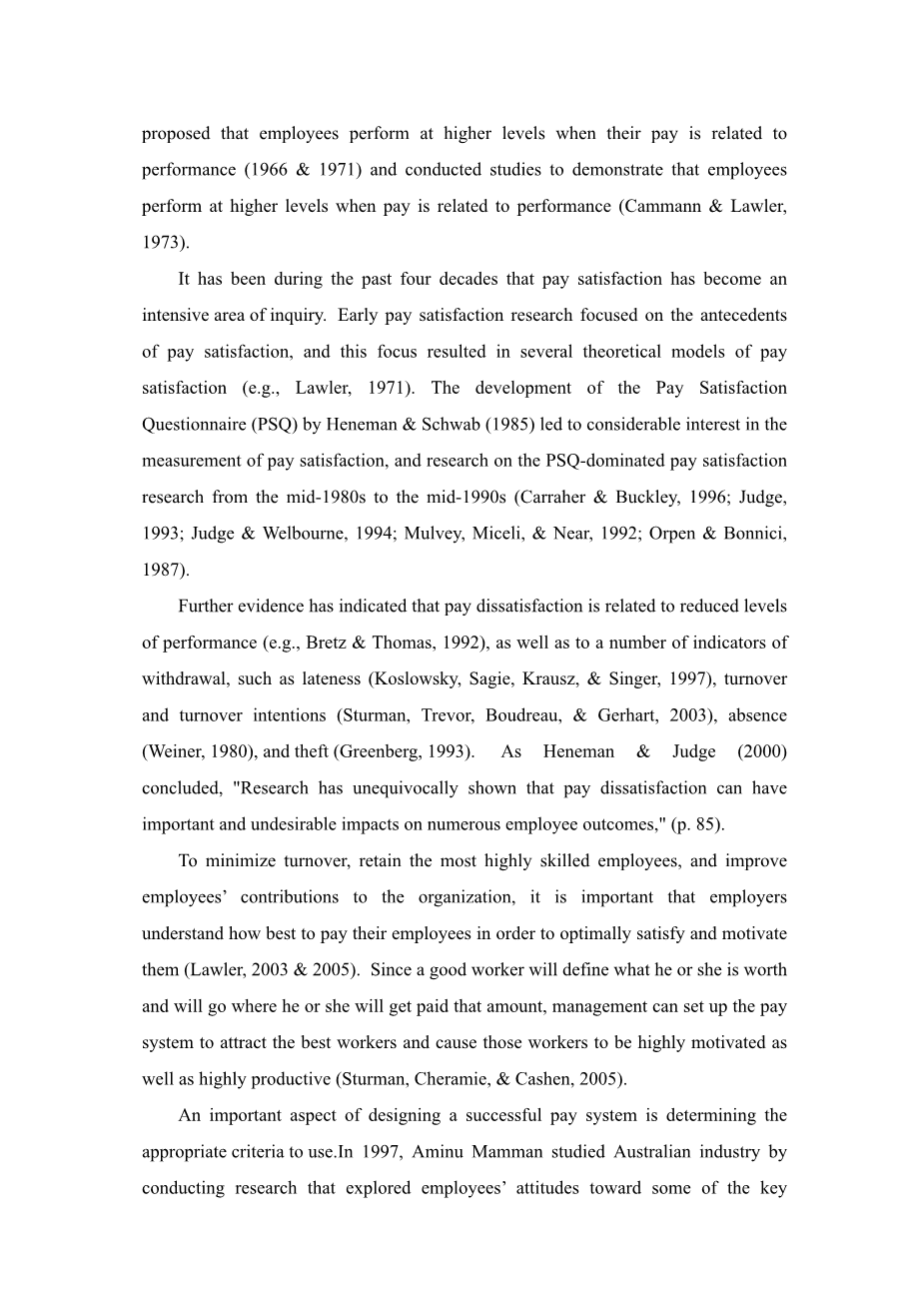

英语原文共 10 页,剩余内容已隐藏,支付完成后下载完整资料
外文文献翻译
外文文献:
EMPLOYEE PREFERENCES FOR PAY SYSTEM CRITERIA: A PAY SYSTEM SURVEY
Background of the Problem
As the 21st Century progresses, the highly competitive environment in which organizations operate and recent events, such as the Dot.com failures and the terrorist attacks of 9/11, have caused numerous companies to downsize, lay-off employees, or reduce employee compensation, including GE, IBM, Citicorp, ATamp;T, Kodak, Goodyear, Exxon, Xerox, TRW, and GM (Bateman amp; Snell, 2004; Lawler, 2005). As a result, retaining the best employees and recruiting people with the greatest potential are vital to the success and survival of the organization (Lawler, 2003 amp; 2005). Reward systems can serve the strategic purpose of attracting, motivating, and retaining people; yet, a complex set of factors is used to determine an employeersquo;s compensation (Bateman amp; Snell, 2004).
The earliest forms of rewards for productivity were food, shelter, and protection, all of which are vital to survival. Yet, the origination of monetary systems caused pay to become the most common form of reward and money has become the medium of exchange for all commodities. The use of economic incentives to motivate people has been a common practice in many societies and has generated a myriad of speculation and a plethora of research (Milkovich amp; Newman, 2005).
Considered to be the father of scientific management, Frederick Taylor is credited with popularizing the use of money as a motivational work tool over a century ago (Bateman amp; Snell, 2004). Numerous theories that are relevant to the use of economic incentives to motivate workers are rooted in Taylorrsquo;s scientific management, including Vroomrsquo;s Expectancy Theory, Herzbergrsquo;s Two-Factor Theory, Skinnerrsquo;s Reinforcement Theory, and Adamsrsquo; Equity Theory (Lawler, 2000).In addition, there is an abundance of research studies that have focused on performance-based pay, of which the most famous are the Hawthorne Studies. Edward E. Lawler furthered the evolution of economic motivation theory when he proposed that employees perform at higher levels when their pay is related to performance (1966 amp; 1971) and conducted studies to demonstrate that employees perform at higher levels when pay is related to performance (Cammann amp; Lawler, 1973).
It has been during the past four decades that pay satisfaction has become an intensive area of inquiry. Early pay satisfaction research focused on the antecedents of pay satisfaction, and this focus resulted in several theoretical models of pay satisfaction (e.g., Lawler, 1971). The development of the Pay Satisfaction Questionnaire (PSQ) by Heneman amp; Schwab (1985) led to considerable interest in the measurement of pay satisfaction, and research on the PSQ-dominated pay satisfaction research from the mid-1980s to the mid-1990s (Carraher amp; Buckley, 1996; Judge, 1993; Judge amp; Welbourne, 1994; Mulvey, Miceli, amp; Near, 1992; Orpen amp; Bonnici, 1987).
Further evidence has indicated that pay dissatisfaction is related to reduced levels of performance (e.g., Bretz amp; Thomas, 1992), as well as to a number of indicators of withdrawal, such as lateness (Koslowsky, Sagie, Krausz, amp; Singer, 1997), turnover and turnover intentions (Sturman, Trevor, Boudreau, amp; Gerhart, 2003), absence (Weiner, 1980), and theft (Greenberg, 1993). As Heneman amp; Judge (2000) concluded, 'Research has unequivocally shown that pay dissatisfaction can have important and undesirable impacts on numerous employee outcomes,' (p. 85).
To minimize turnover, retain the most highly skilled employees, and improve employeesrsquo; contributions to the organization, it is important that employers understand how best to pay their employees in order to optimally satisfy and motivate them (Lawler, 2003 amp; 2005). Since a good worker will define what he or she is worth and will go where he or she will get paid that amount, management can set up the pay system to attract the best workers and cause those workers to be highly motivated as well as highly productive (Sturman, Cheramie, amp; Cashen, 2005).
An important aspect of designing a successful pay system is determining the appropriate criteria to use. In 1997, Aminu Mamman studied Australian industry by conducting research that explored employeesrsquo; attitudes toward some of the key criteria that usually determines pay. For his sampling frame, Mammanrsquo;s (1997) research proved conclusively that an employeersquo;s choice of pay criteria is a function of factors such as education and age. In 1999, James Mirabella expanded on Mammanrsquo;s research by studying American employees, and his research confirmed Mammanrsquo;s conclusions outside the boundaries of Australia.
This research study proposes to further investigate the choice of pay criteria by American employees in the 21st century, especially considering changes in workersrsquo; attitudes resulting from events since the turn of the century. Since the year 2000, numerous events, such as the terrorist attacks of 9/11, the bankruptcy of numerous large corporations, lay-offs, and downsizing have caused conditions in the business environment to become more and more unstable (Bateman amp; Snell, 2004). These unstable and highly dynamic conditions have resulted in numerous corporations seeking the most optimal way to operate, including how to appropriately compensate employees while minimizing costs (Lawler, 2003 amp; 2005). If employers want to optimally satisfy and motivate employees with a pay system, managers need to understand the attitudes and preferences of employees regarding the criteria used to determined pay systems.
Statement of the Problem
Numerous previous studies have researched the relationship between various pay systems and the relative impact on pay satisfaction or overall employe
剩余内容已隐藏,支付完成后下载完整资料
资料编号:[469509],资料为PDF文档或Word文档,PDF文档可免费转换为Word
您可能感兴趣的文章
- 薪酬满意度作为工作满意度的先行因素:建立一个回归模型,确定公共和私人组织中薪酬满意度与工作满意度之间的线性关系外文翻译资料
- 胜任力与胜任力、胜任力模型与胜任力模型的比较研究外文翻译资料
- 如何提高企业网络招聘的有效性外文翻译资料
- 为初级职位招聘大学生,在制定战略和战术校园招聘计划时,需要考虑哪些问题?外文翻译资料
- 基于能力的招聘:招聘和留住成功员工的关键外文翻译资料
- 员工培训对体育门票销售人员工作满意度的影响外文翻译资料
- 由雇主参与的创新型员工激励模式外文翻译资料
- 浅析企业文化与企业绩效的相关性 ——以苏州金色未来信息咨询股份有限公司为例外文翻译资料
- 互联网背景下基于平衡计分卡的计算机绩效评价系统外文翻译资料
- 提高斯洛伐克公共行政部门招聘过程的效率外文翻译资料


